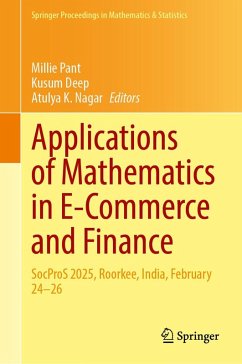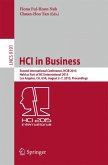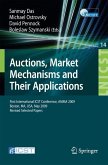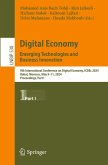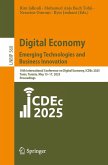Applications of Mathematics in E-Commerce and Finance
SocProS 2025, Roorkee, India, February 24-26
Herausgegeben:Pant, Millie; Deep, Kusum; Nagar, Atulya K.
Applications of Mathematics in E-Commerce and Finance
SocProS 2025, Roorkee, India, February 24-26
Herausgegeben:Pant, Millie; Deep, Kusum; Nagar, Atulya K.
- Gebundenes Buch
- Merkliste
- Auf die Merkliste
- Bewerten Bewerten
- Teilen
- Produkt teilen
- Produkterinnerung
- Produkterinnerung
This book offers a comprehensive collection of 46 research contributions presented at the 13th International Conference on Soft Computing for Problem Solving (SocProS 2025): Artificial Intelligence for Viksit Bharat (that is, developed India), held at the Indian Institute of Technology Roorkee, Uttrakhand, India, from 24-26 February 2025. It discusses how machine learning, deep learning, optimization and intelligent systems are revolutionizing engineering and commercial practices through applications of mathematics. Covering diverse topics such as facial recognition security, cryptocurrency…mehr
Andere Kunden interessierten sich auch für
![HCI in Business HCI in Business]() HCI in Business39,99 €
HCI in Business39,99 €![Auctions, Market Mechanisms and Their Applications Auctions, Market Mechanisms and Their Applications]() Auctions, Market Mechanisms and Their Applications39,99 €
Auctions, Market Mechanisms and Their Applications39,99 €![The Development of Cross-border E-commerce The Development of Cross-border E-commerce]() Qinghong ShuaiThe Development of Cross-border E-commerce106,99 €
Qinghong ShuaiThe Development of Cross-border E-commerce106,99 €![Digital Economy. Emerging Technologies and Business Innovation Digital Economy. Emerging Technologies and Business Innovation]() Digital Economy. Emerging Technologies and Business Innovation98,99 €
Digital Economy. Emerging Technologies and Business Innovation98,99 €![Trust Management in the Chinese E-Commerce Market Trust Management in the Chinese E-Commerce Market]() Yong PanTrust Management in the Chinese E-Commerce Market115,99 €
Yong PanTrust Management in the Chinese E-Commerce Market115,99 €![Strategic Management of International E-Commerce Firms Strategic Management of International E-Commerce Firms]() Marius MüllerStrategic Management of International E-Commerce Firms76,99 €
Marius MüllerStrategic Management of International E-Commerce Firms76,99 €![Digital Economy. Emerging Technologies and Business Innovation Digital Economy. Emerging Technologies and Business Innovation]() Digital Economy. Emerging Technologies and Business Innovation62,99 €
Digital Economy. Emerging Technologies and Business Innovation62,99 €-
-
-
This book offers a comprehensive collection of 46 research contributions presented at the 13th International Conference on Soft Computing for Problem Solving (SocProS 2025): Artificial Intelligence for Viksit Bharat (that is, developed India), held at the Indian Institute of Technology Roorkee, Uttrakhand, India, from 24-26 February 2025. It discusses how machine learning, deep learning, optimization and intelligent systems are revolutionizing engineering and commercial practices through applications of mathematics. Covering diverse topics such as facial recognition security, cryptocurrency and blockchain technologies, automated trading, sustainable inventory management, personalized recommendation systems and IoT-driven smart solutions, the book highlights both theoretical advancements and practical implementations of mathematics across a wide range of disciplines.
This book also addresses emerging areas like green energy management, speech recognition, multilingual language technologies and climate analytics. With a strong emphasis on interdisciplinary research, the chapters integrate computational intelligence, engineering innovations and business applications, providing readers with a holistic view of current trends and future opportunities. This book serves as a valuable reference for researchers, practitioners, industry professionals and students aiming to leverage machine learning and optimization techniques for engineering and e-commerce challenges.
This book also addresses emerging areas like green energy management, speech recognition, multilingual language technologies and climate analytics. With a strong emphasis on interdisciplinary research, the chapters integrate computational intelligence, engineering innovations and business applications, providing readers with a holistic view of current trends and future opportunities. This book serves as a valuable reference for researchers, practitioners, industry professionals and students aiming to leverage machine learning and optimization techniques for engineering and e-commerce challenges.
Produktdetails
- Produktdetails
- Springer Proceedings in Mathematics & Statistics 526
- Verlag: Springer, Berlin; Springer
- Artikelnr. des Verlages: 89566791
- Seitenzahl: 515
- Erscheinungstermin: 25. Januar 2026
- Englisch
- Abmessung: 235mm x 155mm
- ISBN-13: 9789819548125
- ISBN-10: 9819548128
- Artikelnr.: 75676539
- Herstellerkennzeichnung
- Springer-Verlag GmbH
- Tiergartenstr. 17
- 69121 Heidelberg
- ProductSafety@springernature.com
- Springer Proceedings in Mathematics & Statistics 526
- Verlag: Springer, Berlin; Springer
- Artikelnr. des Verlages: 89566791
- Seitenzahl: 515
- Erscheinungstermin: 25. Januar 2026
- Englisch
- Abmessung: 235mm x 155mm
- ISBN-13: 9789819548125
- ISBN-10: 9819548128
- Artikelnr.: 75676539
- Herstellerkennzeichnung
- Springer-Verlag GmbH
- Tiergartenstr. 17
- 69121 Heidelberg
- ProductSafety@springernature.com
Millie Pant is Professor in the Department of Applied Mathematics and Scientific Computing at the Indian Institute of Technology Roorkee, Uttrakhand, India. She specializes in data science and artificial intelligence, with significant contributions to optimization algorithms and their applications. She has a robust publication record and has guided numerous Ph.D. and M.Tech. students, reflecting her commitment to research and education in advanced mathematical and computational methods. Kusum Deep is Full Professor (HAG) in the Department of Mathematics as well as Joint Faculty at the Mehta Family School of Data Science and Artificial Intelligence at the Indian Institute of Technology Roorkee, Uttrakhand, India. Also, she is Visiting Professor, Liverpool Hope University, UK; University of Technology Sydney, Australia; and University of Wollongong, Australia. With B.Sc. Hons and M.Sc. from the Centre for Advanced Studies, Panjab University, Chandigarh, India, she is an M.Phil. gold medalist. She earned her PhD from the University of Roorkee, now the Indian Institute of Technology (IIT) Roorkee, in 1988. She has been a national scholarship holder and a Post-Doctoral from Loughborough University, UK assisted by International Bursary funded by the Commission of European Communities, Brussels. She has won numerous awards like the Khosla Research Award, the UGC Career Award, the Starred Performer of IITR Faculty, best paper awards by the Railway Bulletin of Indian Railways, special facilitation in memory of late Prof. M. C. Puri, the AIAP Excellence Award. She is one of the four women from the IIT Roorkee to feature in the ebook, Women in STEM-2021, celebrating the contributions made by 50 Indian women in STEM published by the Confederation of Indian Industries. According to Stanford University, she falls within the top 2% of the scientists in the world for 2019 and 2020. In 2021 she bagged the prestigious POWER grant awarded by SERB-DST, the Government of India. Atulya K. Nagar is the Foundation Chair Professor in the School of Mathematics, Computer Science and Engineering as well as Pro Vice-Chancellor (Research) at Liverpool Hope University, United Kingdom. He received a prestigious Commonwealth Fellowship for pursuing his doctorate (DPhil) in applied nonlinear mathematics, which he earned from the University of York (UK) in 1996. He holds BSc (Hons), MSc and MPhil (with distinction) in mathematical physics from the MDS University of Ajmer, Rajasthan, India. He is a fellow of the Institute of Mathematics and Its applications (FIMA) and a fellow of the Higher Education Academy (FHEA). His research expertise is in the area of applied nonlinear analysis, natural computing and systems engineering.
Chapter 1. Fooling A Deep Learning
based Facial Expression Recognition System using its Class Activation Map and Differential Evolution.
Chapter 2. Cryptocurrency and Blockchain The Future Of Finance?.
Chapter 3. AI
Powered Custom Emoji Generator: Enhancing Digital Expression and Engagement.
Chapter 4. A Comparative Analysis of Classification with Explainability of Customer Churn Prediction.
Chapter 5. Precision Strontium Detection in Water: A Machine Learning Augmented Flame Photometric Approach.
Chapter 6. Comparative Analysis of Random Forest and SVM for EMG
Based Gesture Recognition.
Chapter 7. Comparative study of CNN and LSTM deep learning models for EMG signals for gesture recognition.
Chapter 8. Data
Driven Insights from High
Dimensional Time
Series Signals: A Comprehensive Analysis Approach.
Chapter 9. An Intuitionistic Fuzzy Differential Equation Approach to Economic Production Inventory Model.
Chapter 10. Observation of Reliability, BER, FER, BLER and throughput during the coexistence of 4G LTE and 5G NR.
Chapter 11. Byzantine Linearizability: Reliable Broadcast, Snapshots and Asset Transfer for Bounded Memory.
Chapter 12. A Green Supply Chain Approach under Market Displacement Factor for Novel and Refurbished Inventory.
Chapter 13. Power Fluctuation Detection Technique in Solar Power Plant Using Machine Learning.
Chapter 14. Benefits of Hybrid Demand in a Sustainable Inventory Model with Advance Payment Discount Facility under Preservation and Green Technology.
Chapter 15. Reducing Operational Costs with Cost
Sensitive XG
Boost
Based Failure Prediction.
Chapter 16. Enhanced Hybrid DEA Approach for Predicting Hotel Efficiency: Probabilistic and Neural Network Approaches.
Chapter 17. End
to
end trained Punjabi ASR system with Tonal Features.
Chapter 18. Granular Ball Random Forest for Robust Classification.
Chapter 19. Tolerance based feature selection of an incomplete interval
valued data.
Chapter 20. Design and implementation of Algorithmic Trading system using Alpaca and Lumibot.
Chapter 21. ML
Maestro: No Code Machine Learning with Interactive Data Visualization.
Chapter 22. A Multimodal Approach to Recommendation Systems: Integrating User Preferences and Item Analysis.
Chapter 23. A Supply Chain Inventory Model with Fuzzy Environment in Circular Economy.
Chapter 24. Object Identification for Visually Impaired using IoT with Image Processing and Voice Conversion.
Chapter 25. Pronominal and Nominal Coreference Resolution in Assamese: A Linguistic Rule
Based Framework.
Chapter 26. Enhanced Sentiment Analysis Using the RoBERTa
GRU Hybrid Model for Noisy Social Media Data.
Chapter 27. Design and Development of a Robust Assamese Language Dataset for Author Attribution.
Chapter 28. Unraveling Plasticity Loss in Deep Neural Networks Under Non
Stationary Objectives.
Chapter 29. Mapping SDG Goals with ESG Strategies using Topic Modeling: An Analysis of FMCG Sector.
Chapter 30. A Comparative Study of Vowel Systems in Five NorthEast Indian Languages: Phonetic Charts and Acoustic Features in Bodo, Karbi, Mising, Nepali, and Tiwa.
Chapter 31. Causal Similarity and Feature Engineering for Stock Movement Prediction.
Chapter 32. Enhancing Interpretability and Diagnostic Accuracy in CNN
Based Mammography Analysis.
Chapter 33. Coral Classification and Detection: Advancing Underwater Imaging for Biodiversity Monitoring.
Chapter 34. FurMatch: A Smart System for Personalized Dog Breed Recommendations.
Chapter 35. Evaluating cultural awareness of prominent Vision Language Models for Assamese Handloom Saree.
Chapter 36. Comparative Analysis of Statistical, Machine Learning, and Deep Learning Models for NIFTY 50 Financial Forecasting.
Chapter 37. Innovative EV charging approach Implicating IoT A Smart and User Friendly Concept.
Chapter 38. Portable, Low
Cost, Capacitor
Loaded On
Field I
V Curve Tracer for Solar Photovoltaic Modules with Low Power Rating.
Chapter 39. Spatial and Temporal analysis of Tropical Indian Ocean Climate modes.
Chapter 40. Urban sprawl: Analyzing Development and Change Detection Using GEE in Vijayawada.
Chapter 41. Ignition Time Prediction of Live Shrubs Using Machine Learning.
Chapter 42. ToMEto: A Fusion Cuisine Platform for Recipe Innovation and Ingredient Substitution.
Chapter 43. Effect of variable thickness on the thermal buckling behavior of functionally graded circular plates.
Chapter 44. Recent Five Years’ Comprehensive Review for Green Supplier Selection with Advanced Decision Techniques.
based Facial Expression Recognition System using its Class Activation Map and Differential Evolution.
Chapter 2. Cryptocurrency and Blockchain The Future Of Finance?.
Chapter 3. AI
Powered Custom Emoji Generator: Enhancing Digital Expression and Engagement.
Chapter 4. A Comparative Analysis of Classification with Explainability of Customer Churn Prediction.
Chapter 5. Precision Strontium Detection in Water: A Machine Learning Augmented Flame Photometric Approach.
Chapter 6. Comparative Analysis of Random Forest and SVM for EMG
Based Gesture Recognition.
Chapter 7. Comparative study of CNN and LSTM deep learning models for EMG signals for gesture recognition.
Chapter 8. Data
Driven Insights from High
Dimensional Time
Series Signals: A Comprehensive Analysis Approach.
Chapter 9. An Intuitionistic Fuzzy Differential Equation Approach to Economic Production Inventory Model.
Chapter 10. Observation of Reliability, BER, FER, BLER and throughput during the coexistence of 4G LTE and 5G NR.
Chapter 11. Byzantine Linearizability: Reliable Broadcast, Snapshots and Asset Transfer for Bounded Memory.
Chapter 12. A Green Supply Chain Approach under Market Displacement Factor for Novel and Refurbished Inventory.
Chapter 13. Power Fluctuation Detection Technique in Solar Power Plant Using Machine Learning.
Chapter 14. Benefits of Hybrid Demand in a Sustainable Inventory Model with Advance Payment Discount Facility under Preservation and Green Technology.
Chapter 15. Reducing Operational Costs with Cost
Sensitive XG
Boost
Based Failure Prediction.
Chapter 16. Enhanced Hybrid DEA Approach for Predicting Hotel Efficiency: Probabilistic and Neural Network Approaches.
Chapter 17. End
to
end trained Punjabi ASR system with Tonal Features.
Chapter 18. Granular Ball Random Forest for Robust Classification.
Chapter 19. Tolerance based feature selection of an incomplete interval
valued data.
Chapter 20. Design and implementation of Algorithmic Trading system using Alpaca and Lumibot.
Chapter 21. ML
Maestro: No Code Machine Learning with Interactive Data Visualization.
Chapter 22. A Multimodal Approach to Recommendation Systems: Integrating User Preferences and Item Analysis.
Chapter 23. A Supply Chain Inventory Model with Fuzzy Environment in Circular Economy.
Chapter 24. Object Identification for Visually Impaired using IoT with Image Processing and Voice Conversion.
Chapter 25. Pronominal and Nominal Coreference Resolution in Assamese: A Linguistic Rule
Based Framework.
Chapter 26. Enhanced Sentiment Analysis Using the RoBERTa
GRU Hybrid Model for Noisy Social Media Data.
Chapter 27. Design and Development of a Robust Assamese Language Dataset for Author Attribution.
Chapter 28. Unraveling Plasticity Loss in Deep Neural Networks Under Non
Stationary Objectives.
Chapter 29. Mapping SDG Goals with ESG Strategies using Topic Modeling: An Analysis of FMCG Sector.
Chapter 30. A Comparative Study of Vowel Systems in Five NorthEast Indian Languages: Phonetic Charts and Acoustic Features in Bodo, Karbi, Mising, Nepali, and Tiwa.
Chapter 31. Causal Similarity and Feature Engineering for Stock Movement Prediction.
Chapter 32. Enhancing Interpretability and Diagnostic Accuracy in CNN
Based Mammography Analysis.
Chapter 33. Coral Classification and Detection: Advancing Underwater Imaging for Biodiversity Monitoring.
Chapter 34. FurMatch: A Smart System for Personalized Dog Breed Recommendations.
Chapter 35. Evaluating cultural awareness of prominent Vision Language Models for Assamese Handloom Saree.
Chapter 36. Comparative Analysis of Statistical, Machine Learning, and Deep Learning Models for NIFTY 50 Financial Forecasting.
Chapter 37. Innovative EV charging approach Implicating IoT A Smart and User Friendly Concept.
Chapter 38. Portable, Low
Cost, Capacitor
Loaded On
Field I
V Curve Tracer for Solar Photovoltaic Modules with Low Power Rating.
Chapter 39. Spatial and Temporal analysis of Tropical Indian Ocean Climate modes.
Chapter 40. Urban sprawl: Analyzing Development and Change Detection Using GEE in Vijayawada.
Chapter 41. Ignition Time Prediction of Live Shrubs Using Machine Learning.
Chapter 42. ToMEto: A Fusion Cuisine Platform for Recipe Innovation and Ingredient Substitution.
Chapter 43. Effect of variable thickness on the thermal buckling behavior of functionally graded circular plates.
Chapter 44. Recent Five Years’ Comprehensive Review for Green Supplier Selection with Advanced Decision Techniques.
Chapter 1. Fooling A Deep Learning
based Facial Expression Recognition System using its Class Activation Map and Differential Evolution.
Chapter 2. Cryptocurrency and Blockchain The Future Of Finance?.
Chapter 3. AI
Powered Custom Emoji Generator: Enhancing Digital Expression and Engagement.
Chapter 4. A Comparative Analysis of Classification with Explainability of Customer Churn Prediction.
Chapter 5. Precision Strontium Detection in Water: A Machine Learning Augmented Flame Photometric Approach.
Chapter 6. Comparative Analysis of Random Forest and SVM for EMG
Based Gesture Recognition.
Chapter 7. Comparative study of CNN and LSTM deep learning models for EMG signals for gesture recognition.
Chapter 8. Data
Driven Insights from High
Dimensional Time
Series Signals: A Comprehensive Analysis Approach.
Chapter 9. An Intuitionistic Fuzzy Differential Equation Approach to Economic Production Inventory Model.
Chapter 10. Observation of Reliability, BER, FER, BLER and throughput during the coexistence of 4G LTE and 5G NR.
Chapter 11. Byzantine Linearizability: Reliable Broadcast, Snapshots and Asset Transfer for Bounded Memory.
Chapter 12. A Green Supply Chain Approach under Market Displacement Factor for Novel and Refurbished Inventory.
Chapter 13. Power Fluctuation Detection Technique in Solar Power Plant Using Machine Learning.
Chapter 14. Benefits of Hybrid Demand in a Sustainable Inventory Model with Advance Payment Discount Facility under Preservation and Green Technology.
Chapter 15. Reducing Operational Costs with Cost
Sensitive XG
Boost
Based Failure Prediction.
Chapter 16. Enhanced Hybrid DEA Approach for Predicting Hotel Efficiency: Probabilistic and Neural Network Approaches.
Chapter 17. End
to
end trained Punjabi ASR system with Tonal Features.
Chapter 18. Granular Ball Random Forest for Robust Classification.
Chapter 19. Tolerance based feature selection of an incomplete interval
valued data.
Chapter 20. Design and implementation of Algorithmic Trading system using Alpaca and Lumibot.
Chapter 21. ML
Maestro: No Code Machine Learning with Interactive Data Visualization.
Chapter 22. A Multimodal Approach to Recommendation Systems: Integrating User Preferences and Item Analysis.
Chapter 23. A Supply Chain Inventory Model with Fuzzy Environment in Circular Economy.
Chapter 24. Object Identification for Visually Impaired using IoT with Image Processing and Voice Conversion.
Chapter 25. Pronominal and Nominal Coreference Resolution in Assamese: A Linguistic Rule
Based Framework.
Chapter 26. Enhanced Sentiment Analysis Using the RoBERTa
GRU Hybrid Model for Noisy Social Media Data.
Chapter 27. Design and Development of a Robust Assamese Language Dataset for Author Attribution.
Chapter 28. Unraveling Plasticity Loss in Deep Neural Networks Under Non
Stationary Objectives.
Chapter 29. Mapping SDG Goals with ESG Strategies using Topic Modeling: An Analysis of FMCG Sector.
Chapter 30. A Comparative Study of Vowel Systems in Five NorthEast Indian Languages: Phonetic Charts and Acoustic Features in Bodo, Karbi, Mising, Nepali, and Tiwa.
Chapter 31. Causal Similarity and Feature Engineering for Stock Movement Prediction.
Chapter 32. Enhancing Interpretability and Diagnostic Accuracy in CNN
Based Mammography Analysis.
Chapter 33. Coral Classification and Detection: Advancing Underwater Imaging for Biodiversity Monitoring.
Chapter 34. FurMatch: A Smart System for Personalized Dog Breed Recommendations.
Chapter 35. Evaluating cultural awareness of prominent Vision Language Models for Assamese Handloom Saree.
Chapter 36. Comparative Analysis of Statistical, Machine Learning, and Deep Learning Models for NIFTY 50 Financial Forecasting.
Chapter 37. Innovative EV charging approach Implicating IoT A Smart and User Friendly Concept.
Chapter 38. Portable, Low
Cost, Capacitor
Loaded On
Field I
V Curve Tracer for Solar Photovoltaic Modules with Low Power Rating.
Chapter 39. Spatial and Temporal analysis of Tropical Indian Ocean Climate modes.
Chapter 40. Urban sprawl: Analyzing Development and Change Detection Using GEE in Vijayawada.
Chapter 41. Ignition Time Prediction of Live Shrubs Using Machine Learning.
Chapter 42. ToMEto: A Fusion Cuisine Platform for Recipe Innovation and Ingredient Substitution.
Chapter 43. Effect of variable thickness on the thermal buckling behavior of functionally graded circular plates.
Chapter 44. Recent Five Years’ Comprehensive Review for Green Supplier Selection with Advanced Decision Techniques.
based Facial Expression Recognition System using its Class Activation Map and Differential Evolution.
Chapter 2. Cryptocurrency and Blockchain The Future Of Finance?.
Chapter 3. AI
Powered Custom Emoji Generator: Enhancing Digital Expression and Engagement.
Chapter 4. A Comparative Analysis of Classification with Explainability of Customer Churn Prediction.
Chapter 5. Precision Strontium Detection in Water: A Machine Learning Augmented Flame Photometric Approach.
Chapter 6. Comparative Analysis of Random Forest and SVM for EMG
Based Gesture Recognition.
Chapter 7. Comparative study of CNN and LSTM deep learning models for EMG signals for gesture recognition.
Chapter 8. Data
Driven Insights from High
Dimensional Time
Series Signals: A Comprehensive Analysis Approach.
Chapter 9. An Intuitionistic Fuzzy Differential Equation Approach to Economic Production Inventory Model.
Chapter 10. Observation of Reliability, BER, FER, BLER and throughput during the coexistence of 4G LTE and 5G NR.
Chapter 11. Byzantine Linearizability: Reliable Broadcast, Snapshots and Asset Transfer for Bounded Memory.
Chapter 12. A Green Supply Chain Approach under Market Displacement Factor for Novel and Refurbished Inventory.
Chapter 13. Power Fluctuation Detection Technique in Solar Power Plant Using Machine Learning.
Chapter 14. Benefits of Hybrid Demand in a Sustainable Inventory Model with Advance Payment Discount Facility under Preservation and Green Technology.
Chapter 15. Reducing Operational Costs with Cost
Sensitive XG
Boost
Based Failure Prediction.
Chapter 16. Enhanced Hybrid DEA Approach for Predicting Hotel Efficiency: Probabilistic and Neural Network Approaches.
Chapter 17. End
to
end trained Punjabi ASR system with Tonal Features.
Chapter 18. Granular Ball Random Forest for Robust Classification.
Chapter 19. Tolerance based feature selection of an incomplete interval
valued data.
Chapter 20. Design and implementation of Algorithmic Trading system using Alpaca and Lumibot.
Chapter 21. ML
Maestro: No Code Machine Learning with Interactive Data Visualization.
Chapter 22. A Multimodal Approach to Recommendation Systems: Integrating User Preferences and Item Analysis.
Chapter 23. A Supply Chain Inventory Model with Fuzzy Environment in Circular Economy.
Chapter 24. Object Identification for Visually Impaired using IoT with Image Processing and Voice Conversion.
Chapter 25. Pronominal and Nominal Coreference Resolution in Assamese: A Linguistic Rule
Based Framework.
Chapter 26. Enhanced Sentiment Analysis Using the RoBERTa
GRU Hybrid Model for Noisy Social Media Data.
Chapter 27. Design and Development of a Robust Assamese Language Dataset for Author Attribution.
Chapter 28. Unraveling Plasticity Loss in Deep Neural Networks Under Non
Stationary Objectives.
Chapter 29. Mapping SDG Goals with ESG Strategies using Topic Modeling: An Analysis of FMCG Sector.
Chapter 30. A Comparative Study of Vowel Systems in Five NorthEast Indian Languages: Phonetic Charts and Acoustic Features in Bodo, Karbi, Mising, Nepali, and Tiwa.
Chapter 31. Causal Similarity and Feature Engineering for Stock Movement Prediction.
Chapter 32. Enhancing Interpretability and Diagnostic Accuracy in CNN
Based Mammography Analysis.
Chapter 33. Coral Classification and Detection: Advancing Underwater Imaging for Biodiversity Monitoring.
Chapter 34. FurMatch: A Smart System for Personalized Dog Breed Recommendations.
Chapter 35. Evaluating cultural awareness of prominent Vision Language Models for Assamese Handloom Saree.
Chapter 36. Comparative Analysis of Statistical, Machine Learning, and Deep Learning Models for NIFTY 50 Financial Forecasting.
Chapter 37. Innovative EV charging approach Implicating IoT A Smart and User Friendly Concept.
Chapter 38. Portable, Low
Cost, Capacitor
Loaded On
Field I
V Curve Tracer for Solar Photovoltaic Modules with Low Power Rating.
Chapter 39. Spatial and Temporal analysis of Tropical Indian Ocean Climate modes.
Chapter 40. Urban sprawl: Analyzing Development and Change Detection Using GEE in Vijayawada.
Chapter 41. Ignition Time Prediction of Live Shrubs Using Machine Learning.
Chapter 42. ToMEto: A Fusion Cuisine Platform for Recipe Innovation and Ingredient Substitution.
Chapter 43. Effect of variable thickness on the thermal buckling behavior of functionally graded circular plates.
Chapter 44. Recent Five Years’ Comprehensive Review for Green Supplier Selection with Advanced Decision Techniques.

